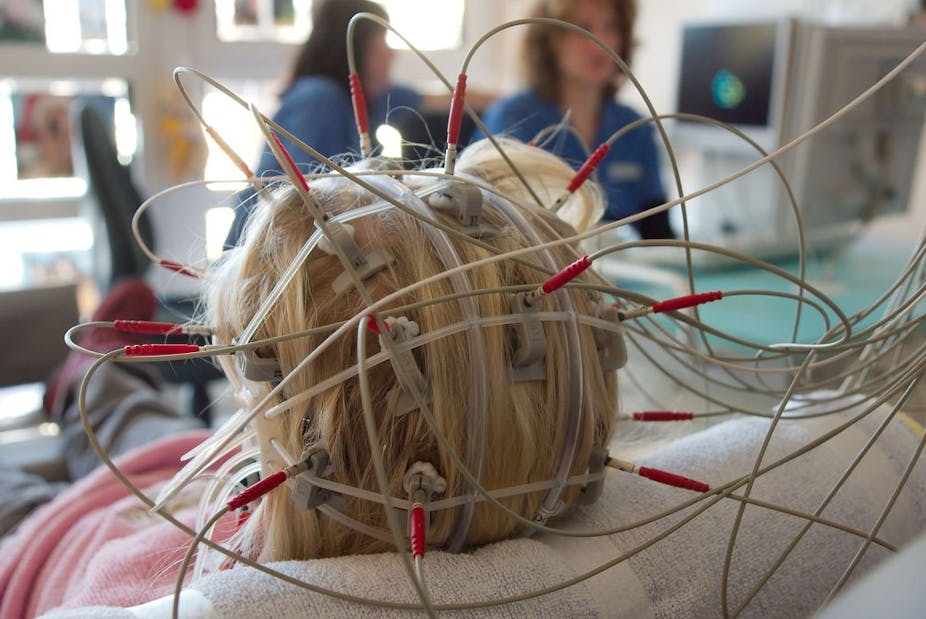Going under a general anaesthetic usually involves sensory checks such as getting you to count down as you lose consciousness. After that an anaesthesiologist will continually monitor your response and heart rate. But cases of “anaesthetic awareness” suggest this point of sensory switch off may not be the full picture.
But by studying electrical activity in the brain during anaesthesia, researchers at Oxford University suggest there is another point where lack of consciousness can be measured - where the number of slow brain waves produced in our brains reaches a plateau.
Using propofol, the anaesthetic most commonly used in operations, the team measured the increase in slow brain wave activity using EEG scans. It was found that this activity, which also increases in our brains at particular times during normal sleep, reached a saturation point where it remained constant even when the dose of propofol was increased.
Hearts and minds
The researchers, who published their findings in Science Translational Medicine, also used fMRI scans to take pictures of the brain and found that the volume of grey matter - areas with lots of neurons that help process sensory information - correlated with when someone reached slow wave saturation. This suggests that grey matter could be used to work out when someone will reach a plateau in their brain’s electrical activity before undergoing an operation.
“We knew that frequency changes in the brain happen as you go through various depths of anaesthesia, but we hadn’t expected this saturation effect,” said Catherine Warnaby, co-author on the study. “We could find the point where people stopped responding to sensory tasks. People drop out at different times. And the point at which they reach saturation also depends on the person.”
“The volume of grey matter also correlated … Grey matter is variable with age which is why we think it could be individualised. We already know that people who are older generally need less anaesthetic.”
She added: “Anaesthesiologists can eliminate the risk of awareness by giving a larger dose. But this work shows a potential to optimise the dose if needed. Clinicians monitor heart rate and watch patients - but not the brain.”
The team slowed down the rate at which they gave propofol to test subjects - instead of one large dose, the anaesthetic was administered over 45 minutes. This allowed them to test different levels of consciousness using EEG and also sensory tasks including a word association test and a pain threshold test using a laser pin-prick.
A breakdown of communication
Despite being given to millions of people each year, there is much we still don’t know about the exact mechanisms behind how anaesthetics work in the brain - and how unconsciousness happens. The “information integration” theory of consciousness, which is widely held, holds that different parts of the brain simultaneously communicate and process individual bits of information, and breaking down this communication system leads to a loss of consciousness - or response to sensory stimuli.
Activity in the thalamus region of the brain has been shown to reduce as we lose consciousness, which has led some to believe that this region of the brain is the “switch” behind the breakdown of communication.
In their study, the Oxford researchers showed that as slow brain waves began to plateau, this thalamocortical system stopped responding to sensory stimuli but continued to process internal information, at which point another cortical network in the brain did respond.
George Mashour, an anaesthesiologist from the University of Michigan Medical School, said:
“Much in known about how the EEG reflects the effects of various anaesthetics. For example, that slow waves increase and that they tend to be localised. This study adds to our knowledge by linking these observations to neural events that occur deep in the cortex.”
“Because the slow waves are manifest primarily in the frontal cortex — which we usually have access to in the operating room — this scientifically sophisticated study has practical implications. Importantly, the study suggests the possibility of an individualised biomarker, in contrast to statistical approaches that primarily show differences between groups.”
Avoiding the ‘third state’
Anaesthetic awareness, where patients have some level of feeling or memory of an operation while under was recently described by one consultant as “third state of consciousness” which may happen more often than we think - though it is still generally considered rare. Working out whether this is happening, however, isn’t easy. Some studies have sought to test awareness, whereas others have used information gathered from patients retrospectively.
“‘Anaesthetic awareness’ is really a composite concept that includes both consciousness and explicit memory of a surgical event,” Mashour said. “In terms of monitoring levels of awareness in real time we have no standard method, which is surprising considering that the brain is one of the target organs of general anaesthesia.”
While the science had not yet fully reached the operating room, Manshour said: “We are currently in an exciting era because the neuroscience of consciousness is starting to influence our approach to monitoring the brain during general anaesthesia.”

